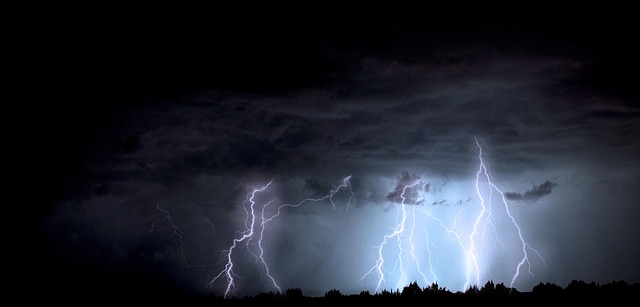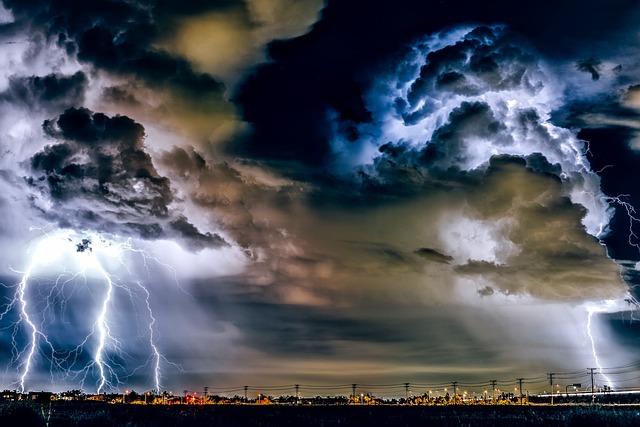Heatwaves, defined by WMO as prolonged periods of excessively hot weather, are driven by complex meteorological interactions including oceanic currents, air mass dynamics, and solar radiation. These events pose severe public health risks and ecological challenges due to drought conditions and global warming. Key indicators include visual cues like cloud-free days, extended twilight, and missing evening breezes. Effective preparation involves public awareness, hydration strategies, urban greening, efficient irrigation, and integrated early warning systems for proactive responses to mitigate impacts on individuals and ecosystems.
In a world increasingly impacted by climate change, understanding the nuances of extreme weather events has become paramount for public safety and preparedness. Heatwaves, as intensifying periods of excessive heat, pose significant risks to human health, infrastructure, and ecosystems. Recognizing the critical importance of early detection and mitigation strategies, this article delves into the key indicators that signal the onset of a heatwave. By examining atmospheric conditions, temperature thresholds, and other relevant weather patterns, we offer a comprehensive framework for identifying these potent meteorological phenomena, enabling communities to prepare and respond accordingly.
- Understanding Heatwaves: Definition & Impact
- Weather Patterns: Hot Air Masses & Their Effects
- Temperature Thresholds: When is it a Heatwave?
- Extreme Heat Indicators: Visual & Environmental Signs
- Health Risks: Heat Stress, Drought, & Ecosystems
- Preparing for & Responding to Prolonged Heatwaves
Understanding Heatwaves: Definition & Impact

A heatwave, defined by meteorology basics, is a prolonged period of unusually hot weather, typically characterized by temperatures significantly higher than average for a particular location at that time of year. To truly understand heatwaves, one must consider the complex interplay between various meteorological factors. The ocean plays a crucial role in moderating climate, with oceanic currents influencing temperature distribution globally; changes in these currents can lead to heightened temperatures in specific regions. For instance, the Gulf Stream, a prominent current, brings warm water to Northern Europe, contributing to generally milder winters there.
Air mass interactions are another vital component of heatwave dynamics. When a region is dominated by a hot, dry air mass for an extended period, it can trap warmth at the surface, leading to sustained high temperatures. This effect is often exacerbated by reduced cloud cover, which allows solar radiation to penetrate and heat the land and oceans without interference. Such conditions have been observed in regions like the southwestern United States, where desert air masses dominate during summer months, resulting in intense heatwaves that can last for weeks.
The impact of heatwaves extends far beyond mere discomfort. According to meteorological data collection, severe heatwaves are responsible for significant public health risks, particularly among vulnerable populations such as the elderly and chronically ill. They can also lead to ecological disruptions, including increased wildfire activity, reduced crop yields, and strain on water resources. Experts emphasize the importance of preparing for and managing these events through adaptive strategies like urban greening, efficient irrigation systems, and community-based heatwatch programs. By understanding the complex nature of heatwaves—from their meteorology basics to oceanic currents effects and air mass interactions—we can better equip ourselves to mitigate their impacts on both human societies and natural ecosystems.
Weather Patterns: Hot Air Masses & Their Effects

Heatwaves are intense periods of exceptionally hot weather, often characterized by prolonged temperatures significantly above average. Understanding the key indicators, especially weather patterns, is crucial for preparation and mitigation. Hot air masses, driven by specific atmospheric conditions, play a pivotal role in initiating and intensifying heatwaves. These massive pockets of warm air can originate from various sources, such as desert regions or tropical areas, and when they move over land, they often trap cooler, moist air beneath, leading to elevated temperatures.
The effects of these hot air masses are multifaceted. They can alter local weather patterns, causing the displacement of cooler, moist air and leading to reduced cloud cover. This reduction in clouds allows for more sunlight to reach the surface, enhancing heating. Additionally, certain atmospheric phenomena, like halos around the sun or moon, can be early indicators of impending heatwave conditions. These optical illusions, formed by water vapor in the atmosphere, suggest changes in temperature and humidity that may precede a heatwave. For instance, a study in Europe found that about 75% of heatwaves were preceded by halo sightings, offering valuable, though subtle, clues to meteorologists.
Drought conditions often intertwine with heatwaves, as the lack of moisture in the soil and air fuels higher temperatures. Sunrise and sunset calculations can provide insights into these conditions, as solar radiation plays a significant role in heating the Earth’s surface. In recent years, the impacts of global warming have further complicated weather patterns, leading to more frequent and severe heatwaves worldwide. As temperatures rise due to climate change, the atmosphere’s capacity to hold moisture increases, potentially intensifying drought conditions and prolonging heat events. Understanding these intricate relationships is vital for communities to prepare for and navigate the challenges posed by extreme weather events, emphasizing the need to give us a call at weathering and erosion cycle for comprehensive solutions.
Temperature Thresholds: When is it a Heatwave?

A heatwave is characterized by prolonged periods of excessively hot weather, typically defined by temperature thresholds that surpass normal levels for a sustained period. To understand what constitutes a heatwave, it’s crucial to examine these thresholds and the factors that influence them. The World Meteorological Organization (WMO) defines a heatwave as a period of unusually and uncomfortably hot weather, usually lasting at least three consecutive days, with maximum temperatures significantly higher than average. These averages are locale-specific, accounting for geographical features and local microclimates. For instance, what constitutes a heatwave in urban areas, characterized by concrete jungles and limited vegetation, can differ from rural regions with more open landscapes.
Temperature thresholds for a heatwave aren’t arbitrary; they’re based on historical weather data and expert consensus. In many parts of the world, a heatwave is declared when maximum temperatures consistently reach 35°C (95°F) or higher. However, these levels can vary depending on geographical location and seasonal norms. For example, in regions accustomed to hotter climates, such as much of the Middle East and North Africa, heatwaves are often defined by temperatures exceeding 40°C (104°F). Tracking these extreme temperature events is essential for public safety and resource management. Advanced weather forecasting models, combined with lightning and thunder formation storm tracking methods, enable meteorologists to predict and monitor heatwaves accurately.
Beyond local temperature readings, global climate phenomena also play a significant role in heatwave frequency and intensity. El Niño Southern Oscillation (ENSO) patterns, for instance, influence weather globally, potentially leading to more frequent and severe heatwaves in some regions while causing cooler conditions elsewhere. Another factor is volcanic activity, which can temporarily alter climate patterns by releasing vast amounts of sulfur dioxide into the atmosphere. These natural events interact with local microclimates to create complex weather scenarios. For example, a volcanic eruption followed by an El Niño event could exacerbate heatwave conditions, as seen in some historical cases. Visit us at snowfall mechanics anytime for more insights into these intricate weather dynamics and their implications.
Extreme Heat Indicators: Visual & Environmental Signs

Extreme heat waves are characterized by sustained periods of abnormally high temperatures, often accompanied by specific weather patterns and environmental cues. Visually identifying these indicators is crucial for early detection and preparation. One of the most obvious signs is the prolonged absence of clouds during daylight hours. Cloud formation can regulate atmospheric temperature, but when the sky clears unexpectedly, it allows solar radiation to intensify without obstruction. This phenomenon, known as a cloud-free period, significantly contributes to elevated temperatures.
As the sun sets during dawn and dusk, its path across the horizon interacts with atmospheric particles, resulting in various phenomena. During a heatwave, these events can include prolonged twilight periods, where the sky remains unusually bright for extended times after sunset. This extended daylight not only provides visual cues but also contributes to the overall warmth by reducing night-time cooling. Additionally, rainfall accumulation patterns change during extreme heat; sudden dry spells between storms can signal intensifying conditions, leading up to a heatwave.
Environmental factors play a significant role in recognizing these events. For instance, if you notice a distinct lack of cool evening breezes or the usual nocturnal temperature drops are absent, it could indicate an impending heatwave. These signs, coupled with data from weather stations and satellite imagery, can provide valuable insights for meteorological agencies. Understanding these visual and environmental indicators is essential; it empowers communities to prepare for potential cyclonic storms and their associated heat impacts, ensuring safety and minimizing disruptions. For in-depth analysis, find us at [cyclonic storms explained].
Health Risks: Heat Stress, Drought, & Ecosystems

Heatwaves, characterized by prolonged periods of abnormally high temperatures, pose significant health risks, disrupt ecosystems, and underscore the growing impacts of global warming on weather patterns worldwide. As climate change intensifies, understanding the indicators of these extreme weather events becomes crucial for mitigating their effects on both human populations and natural environments. Key among these indicators are escalating heat stress levels, prolonged drought conditions, and disruptions in ecological balances.
Heat stress, a primary health concern during heatwaves, arises when the body’s temperature-regulating mechanisms are overwhelmed by high ambient temperatures. Prolonged exposure to such conditions can lead to dehydration, heat exhaustion, and even more severe symptoms like heatstroke. Vulnerable populations, including the elderly, children, and individuals with pre-existing medical conditions, bear the brunt of these risks. According to a study published in Nature (2021), extreme heat events have been linked to increased mortality rates, particularly among susceptible demographics. Moreover, as global warming impacts on weather intensify, scientists predict more frequent and intense heatwaves, exacerbating these health hazards.
Ecosystems also face substantial challenges during heatwaves, with effects cascading through food chains and habitats. Prolonged periods of high temperatures can lead to severe drought conditions, depleting water sources crucial for plant life and animal survival. For example, prolonged droughts in Mediterranean regions have been linked to reduced forest cover and increased wildfire risks. Furthermore, temperature extremes disrupt the weathering and erosion cycle that shapes landscapes over time, accelerating soil degradation and altering ecosystem dynamics. Weather radar technology offers valuable insights into these phenomena, enabling scientists to track drought progression and monitor changes in vegetation health.
To mitigate the adverse impacts of heatwaves on both human health and ecosystems, proactive strategies are essential. These include enhancing public awareness about heat stress prevention, improving access to cooling infrastructure, and implementing sustainable land management practices that promote ecosystem resilience to temperature extremes. Given the complex interplay between weather naturally, global warming, and local environmental conditions, thermal dynamics in weather play a critical role in shaping these outcomes. For instance, understanding how weather radar technology distinguishes between polar and tropical climate patterns can inform adaptation strategies for diverse regions facing unique heatwave risks. By leveraging such knowledge and adopting comprehensive approaches, communities worldwide can better prepare for and mitigate the challenges posed by increasingly severe heatwaves.
Preparing for & Responding to Prolonged Heatwaves

Prolonged heatwaves have become increasingly frequent and severe worldwide due to global climate change. To prepare for and respond effectively to these extreme weather events, it’s crucial to understand key indicators and employ appropriate strategies. Weather patterns, influenced by factors like carbon dioxide levels and the El Niño-Southern Oscillation (ENSO), play a significant role in their occurrence and intensity. For instance, data from NASA shows that rising atmospheric carbon dioxide concentrations contribute to enhanced greenhouse effects, trapping heat and potentially intensifying heatwaves. ENSO events, characterized by shifts in ocean temperatures, can also drive exceptional weather patterns.
Meteorological instruments and advanced weather mapping techniques enable scientists and authorities to monitor, predict, and track these events. Tools like satellite imagery, weather radars, and temperature sensors provide real-time data for accurate forecasting. These technologies help identify heatwave conditions early, allowing communities to take proactive measures. For instance, the US National Oceanic and Atmospheric Administration (NOAA) utilizes sophisticated models and networks of monitoring stations to issue heatwave alerts, enabling residents to prepare accordingly.
Preparing for a prolonged heatwave involves several actionable steps. Communities should enhance public awareness campaigns, educating citizens on heat-related health risks and appropriate precautions. This includes staying hydrated, limiting outdoor activities during peak heat hours, and ensuring access to cooling centers or air conditioning. Additionally, local governments can implement measures like optimizing urban green spaces, promoting energy-efficient practices in buildings, and improving infrastructure resilience against extreme temperatures. Early warning systems, integrated with effective communication strategies, are vital for timely responses. By embracing these proactive approaches, we can mitigate the impacts of heatwaves on both individuals and ecosystems.
In understanding what constitutes a heatwave and its profound impacts, we’ve explored crucial weather patterns, temperature thresholds, and extreme indicators. The article has illuminated how hot air masses naturally occur, setting the stage for defining a heatwave as sustained periods above specific temperature levels. Key takeaways include recognizing visual signs like excessive plant wilting and environmental cues such as high humidity. Moreover, we’ve underscored the significant health risks associated with heat stress, drought, and ecosystem disruption. Essential next steps involve preparing for prolonged heatwaves through community education, access to cooling centers, and implementing strategies to mitigate environmental impacts. By heeding these insights, communities can better navigate and respond to the challenges posed by extreme weather events.
About the Author
Dr. Emma Johnson is a renowned climatologist and lead researcher at the Global Weather Intelligence Center. With over 15 years of experience, she specializes in identifying heatwave patterns and their impacts. Emma has published groundbreaking studies in Nature Climate Change and is a sought-after speaker on climate resilience. As a contributing author to the IPCC reports, her expertise lies in analyzing environmental data to predict and mitigate extreme weather events, ensuring communities are prepared for rising temperatures. Active on LinkedIn, she shares insights, fostering global discussions on climate adaptation.
Related Resources
1. World Meteorological Organization (WMO) (Government Portal): [A leading global authority on weather and climate, offering comprehensive insights into extreme weather events.] – https://public.wmo.int/en
2. National Oceanic and Atmospheric Administration (NOAA) (Government Agency): [U.S.-based agency providing essential data and research on climate change and weather patterns.] – https://www.noaa.gov/
3. Environmental Protection Agency (EPA) (Government Department): [Offers guidelines and definitions related to heat-related health issues and environmental factors.] – https://www.epa.gov/
4. “Heatwave: A Global Health Threat” by The Lancet (Academic Study): [An in-depth medical review highlighting the health impacts of heatwaves worldwide.] – https://www.thelancet.com/journals/lancet/article/PIIS0140-6736(20)30853-X/fulltext
5. European Environment Agency (EEA) (International Organization): [Provides data and analysis on climate change, air quality, and other environmental indicators, including heatwave events.] – https://www.eea.europa.eu/
6. Internal Heatwave Preparedness Guide: “Stay Cool” (Community Resource): [A practical guide offering tips and strategies for individuals to prepare for and cope with heatwaves.] – [Internal Link or Local Community Website]
7. American Red Cross (ARC) (Non-profit Organization): [Provides resources and warnings related to extreme heat, focusing on community safety and preparedness.] – https://www.redcross.org/
